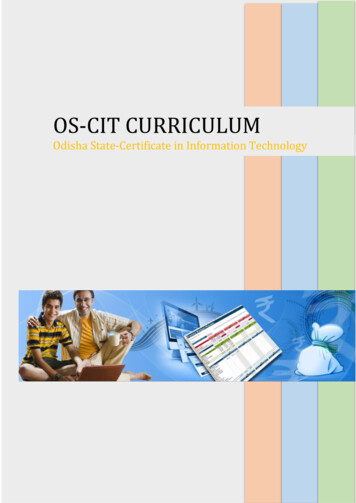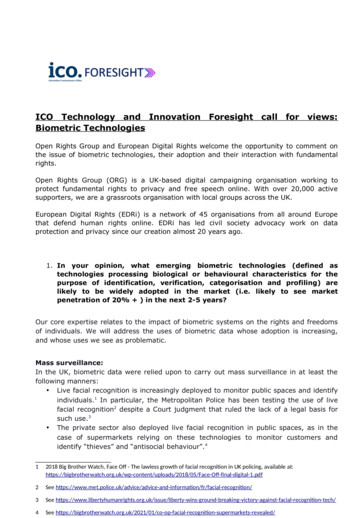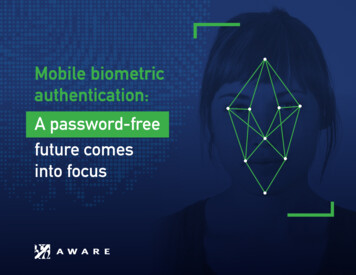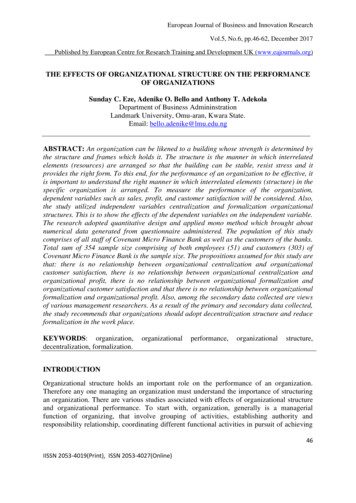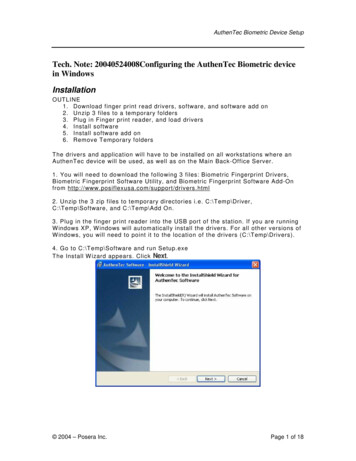
Transcription
India’s “Aadhaar” Biometric ID: Structure,Security, and VulnerabilitiesPratyush Ranjan Tiwari?1 , Dhruv Agarwal?2 , Prakhar Jain3 , SwagamDasgupta4 , Preetha Datta5 , Vineet Reddy6 , and Debayan Gupta71Johns Hopkins University, 2 Microsoft Research, 3 Fractal Analytics, 4 BastionMedia, 5 Aalto University, 6 Northeastern University, 7 Ashoka UniversityAbstract. India’s Aadhaar is the largest biometric identity system inhistory, designed to help deliver subsidies, benefits, and services to India’s 1.4 billion residents. The Unique Identification Authority of India(UIDAI) is responsible for providing each resident (not each citizen) witha distinct identity—a 12-digit Aadhaar number—using their biometricand demographic details. We provide the first comprehensive descriptionof the Aadhaar infrastructure, collating information across thousandsof pages of public documents and releases, as well as direct discussionswith Aadhaar developers. Critically, we describe the first known cryptographic issue within the system, and discuss how a workaround preventsit from being exploitable at scale. Further, we categorize and rate various security and privacy limitations and the corresponding threat actors,examine the legitimacy of alleged security breaches, and discuss improvements and mitigation strategies.Keywords: Resident Identification · Biometric · Security & Privacy1IntroductionResident identification systems are pervasive in the world today, with many usingbiometrics [15]. These systems hold and mediate vast amounts of private data,which in many cases is also used to facilitate welfare schemes and other publicprograms. Aadhaar is a 12-digit unique ID issued by the Indian government toeach Indian resident (not citizen), using their demographic and biometric information. To date, over 1.3 billion residents have been enrolled [35]: it is the largestbiometric identity system ever built and is linked to bank accounts, income taxnumbers, social security schemes, etc. And while Aadhaar is technically not required for many things (such as getting a new cellular connection), its ubiquityhas rendered it the default form of identification in India.Though public trust in Aadhaar is crucial, the system has been relativelyopaque, leading to much confusion and speculation. Civil activists [4] and media outlets [42] have alleged that Aadhaar is vulnerable to numerous types ofbreaches; corroborating these claims is difficult as there exists no comprehensive?Indicates equal contribution. 1 pratyush@cs.jhu.edu, 2 t-dhaga@microsoft.com
2Tiwari and Agarwal et al.resource detailing Aadhaar’s system and security architecture. Public documentation about Aadhaar is outdated or ambiguous, and no unified description ofthe infrastructure exists. As a result, one has to collate information from multiple (often unreliable) sources. We present the first comprehensive description ofAadhaar, analyze all reported privacy or security breaches, and assess defensesagainst future attacks. We also report the first known1 cryptographic issue (fortunately not exploitable at scale under current conditions) in the system.Contributions. Comprehensive snapshot: We outline the journey of an individual’s data through the Aadhaar system and the entities involved (for datacollection, processing, storage, and usage), covering the entire body of publiclyavailable information on Aadhaar. Previous work has looked at authenticationor verification, etc. [4,31], but none have covered the whole infrastructure.Security flaws: We analyze all documentation made public by UIDAI — trawlingthrough thousands of pages over time — as well as all alleged attacks to compileand analyze possible security issues. We find that the way Aadhaar generatesIVs for AES (it uses AES-GCM) opens up the possibility to mount an identityforgery attack and steal data. We note that the attack is not currently deployable:we have made sure that this is not exploitable before publishing. However, anybatching of queries or capture of multiple messages within the same second maystill render the system insecure. Specifically, one could forge the identity of anyindividual whose Aadhaar number is available2 .1.1Paper OverviewSection 2 provides a brief background and discusses related work. A list of allabbreviations, in order of appearance, is provided in Appendix B. Section 3 describes Aadhaar’s infrastructure in detail (along with data privacy and securitypolicies)3 This snapshot is divided into the following main sections: the Enrollment Ecosystem (Section 3.1), the Authentication Ecosystem (Section 3.2),the Central Identities Data Repository or CIDR (Section 3.3). Section 4 detailsthe security of different endpoints at which an individual’s data is vulnerableto attacks. Section 5 discusses information security in Aadhaar, using standardbenchmarks. We define the threat model and discuss a cryptographic flaw weidentified and its mitigation strategies (5.2). We use the threat model along withthe snapshot, in Section 6, to filter legitimate attacks from our database of mediaallegations (Section 6.1). We discuss possible attacks, categorize the feasibilityof these breaches based on the threat actor involved, cost (time and resources)and the level of security provided by Aadhaar (Section 6.2). Section 6.3 discusses123Media reports have alleged flaws in associated organizations, or engineering/policyflaws (e.g., software bugs), but a cryptographic flaw within the Aadhaar infrastructure itself has never been discussed.Collections of Aadhaar numbers have been leaked at various times by multiple organizations, though never by UIDAI itself.We collate information from myriad technical reports, policy documents, Memorandaof Understanding (MoUs), and circulars published and signed by UIDAI and otherorganizations in Aadhaar infrastructure. We archive these reports here.
India’s “Aadhaar” Biometric ID3technical and structural mitigation strategies for each type of breach. A studyof alleged attacks is provided in supplementary analysis C.2BackgroundThe Unique Identification Authority of India (UIDAI) was established in January2009. Its mission was to issue a unique identification (UID) number, an “AadhaarNumber,” to every resident of the country. The UID’s purpose was to be a onestop identification that is eventually linked to every social service to make thedisbursement of welfare services effective and efficient (by reducing leakages).The bill that provides legal backing to Aadhaar is called the “Aadhaar (TargetedDelivery of Financial and other Subsidies, benefits and services) Act.” Apartfrom providing Indian residents with a unique identity (an Aadhaar number), theUIDAI is also responsible for providing a platform for residents to authenticatetheir physical presence [65] at a point of service. Aadhaar’s policies regarding itsvision, ethical implications, data security, and privacy have been under intensescrutiny [21]. This becomes all the more important with Aadhaar’s ubiquity. Itis different from login.gov [5,11], for example. It is not merely a single point ofcontact system for welfare. Aadhaar is what you can use to get on a plane, toopen a bank account, to get a phone connection. Getting tested or vaccinatedfor COVID-19? Aadhaar. It is MOSIP [41] on steroids: closed-source, universal,and practically (although not officially) mandatory.2.1Related WorkNational identification projects of many countries have attracted considerableacademic research — Jamaica’s attempt [34], Nepal’s National Identity Project(NIDP) [3], UAE’s ID system [6], Europe’s e-ID systems [9], United States’ Social Security Number [18], etc. Being the world’s largest biometric ID system,India’s Aadhaar has been an active research topic in the areas of ICTD, HCI,security, and privacy. Singh and Jackson [36] perform an ethnographic study ofAadhaar. They find exclusion of people in various phases: during enrollment,while authenticating, and while linking (“seeding”) their Aadhaar numbers withexisting public welfare databases (like the Public Distribution System database).Srinivasan and Johri [37] draw similarities between the legitimization and support tactics of Aadhaar and previously successful infrastructure projects likerailroads in British India and dams in post-Independence India.Prior security and privacy works have recommended using a Trust and RoleBased Access Control Model for internal Aadhaar processes and using cryptography to prevent illegal tracking and profiling [31]. Rajput and Gopinath [32]have analyzed the privacy of authentication workflows offered by Aadhaar andrecommended new ones. The work of Agrawal, Banerjee and Sharma [4], thoughrelatively informal, is the closest to ours. It provides a broad analysis of Aadhaar’s vulnerabilities like faking biometrics, identification without consent, andillegal tracking by collation of data across service providers. Our work differs
4Tiwari and Agarwal et al.Fig. 1: Flowchart of Aadhaar’s architecture. Yellow cells depict entry points into theenrollment (left) and authentication (right) ecosystems. Enrollment starts with theresident visiting the Enrollment Agency which uses an enrollment software providedby the Enrollment Service. The data is then sent to the Registrars for verification.If de-duplication succeeds, the data is stored in the CIDR and the user is enrolled.The authentication procedure starts with the Aadhaar holder’s information reachingthe CIDR via AUA and ASA. The biometric data is captured by the authorizationdevices, sent to the CIDR through AUA and ASA. The response is sent back by theCIDR via the same route.from these: we present a detailed overview of the system and do not assume thecorrectness of media allegations and activism (which are essential in their ownright). Instead, we analyze Aadhaar’s security and allegations against it basedon an extensive study of available documentation.3Snapshot: Aadhaar System DesignAadhaar has three primary components: (1) the Enrollment ecosystem, (2) theAuthentication ecosystem, and (3) the CIDR (Central Identities Data Repository). Enrollment handles onboarding and assigning of unique identity numbers.Authentication provides verification services when residents want to prove theiridentity. CIDR is a database that stores the collected biometric and demographicdata. We provide an overview of a typical resident’s interaction with the Aadhaarsystem and then discuss its usability and the three components.System Overview. Let us start with Anita, a resident of India, who approaches an Enrollment Centre run by an Enrollment Agency (EA) to get registered into the Aadhaar system. She fills her personal details in the EnrollmentForm and submits it to an Enrollment Officer (EO). The EO uses the EnrollmentClient software to record her biometrics (photograph, iris scan, and fingerprints)and enter her demographic details into the system. Anita has carried her originaldocuments as proof of identity and address, which were scanned and returned toher by the EO. Anita’s personal information is encrypted and uploaded to theCIDR for deduplication to ensure that no one is enrolled twice. After successfuldeduplication, Anita receives a letter containing a randomly generated Aadhaarnumber, which her information can be authenticated against throughout her life.Now, say Anita wants to draw her pension and needs to verify her identity.This is carried out by AUAs/KUAs (Authentication/e-Know Your Customer
India’s “Aadhaar” Biometric ID5User Agency): The pension office (an AUA/KUA) asks Anita for her Aadhaarnumber and fingerprints, and sends an authentication request to the CIDR,which returns a Yes/No response (“Yes, this is Anita”/not); it may similarlyverify Anita’s age. The UIDAI mandates the pension office (all AUA/KUAs) tohave a local “Aadhaar Data Vault” to store Aadhaar data securely. (See Figure 1.) Since Anita shared her Aadhaar number with the pension office, UIDAIensures that Anita’s data is secure in the Aadhaar Data Vault and that its usage does not reveal any unknown information about Anita. The vault is locatedwithin the organization’s infrastructure and contains Aadhaar numbers collectedby any agencies for purposes under the Aadhaar Act and Regulations, 2016, accessible only on a “need-to-know” basis. Anita can update her Aadhaar data byvisiting any Enrollment Centre. She must carry her original documents and paya small fee to update her details. She may also update her demographic data(not biometric data) online by uploading required documents to the SSUP (SelfService Update Portal). She also can update her address via SSUP without official proof of address. In this case, UIDAI will send Anita an Address ValidationLetter to her present address, which could be used as proof for an online update.Usability of Aadhaar. The entire process assumes significant privilege:that a resident can read and speak fluently, has a phone (for many services,a smartphone), access to the internet, etc. Also, during the COVID pandemic,many centers are either fully or partially shut down: simple tasks such as linkinga mobile number to one’s Aadhaar for the first time have turned herculean. Ifone’s Aadhaar number is lost (e.g., loss of card), there is no way to recover it forsomeone without a mobile phone (or an unlinked phone). This can result in lossof welfare [7], and restoring the UID is incredibly difficult. On the other hand,there is no way to remove one’s data from the CIDR if the citizen wants/needsthis (e.g., changing residency to another country). There are also on-groundissues like the prevalent use of the Aadhaar “card” or a photocopy as a visualproof of identity without biometric validation (e.g., at airports).3.1Enrollment EcosystemThe Enrollment ecosystem (Figure 2) handles onboarding of residents into Aadhaar with the objective of providing each resident with a unique ID (UID). It alsohandles updating of demographic and biometric details of existing UID holders.Residents enroll only once but may request updates. The ecosystem is designedto work offline to allow enrollment of residents from areas that lack connectivity.There are two major actors: Registrars and Enrollment Agencies (EAs). UIDAIappoints Registrars, and each Registrar appoints EAs under it.Registrar: UIDAI partners with various ministries, banks, public sector organizations, and other agencies that interact with Indian residents [63,68] tofacilitate issuing Aadhaar numbers by enrolling residents and validating residentdata during enrollment and updation. Registrars must take special measuresto enroll women, children, persons with disabilities, unskilled workers, nomadictribes, and people belonging to marginalized groups who cannot produce a validProof of Identity (PoI) and/or Proof of Address (PoA) [63]. “Introducers” are
6Tiwari and Agarwal et al.individuals (such as Registrar employees, members of local administrative andelected bodies, etc.) recognized by Registrars to confirm resident data withoutPoI or PoA. Registrars must follow protocols and standards prescribed by theUIDAI. They usually outsource these tasks to EAs. While they are responsible for the correct functioning of these EAs, there is no mention of Registrarshaving to inform UIDAI about the EAs. A Registrar uses a UIDAI developedEnrollment Client to enroll residents, and must follow the Demographic DataStandards and Verification Procedure (DDSVP) [44].Security (Policy and Logs) The MoUs between Registrars and UIDAI specifythat UIDAI periodically audits the Registrars and EAs (frequency not specified).Although the standard penalties are nowhere specified, if a Registrar fails to follow the security mandates, UIDAI will only make “reasonable attempts” [68] todiscuss and resolve difficulties with the Registrar. Organizations have been penalized in the past: UIDAI terminated a Registrar’s contract citing “enormousnumber of complaints of corruption and enrollment process violations againstAadhaar Enrollment/Update Centres under CSC e-Gov.” [38]Enrollment Agency Registrars employ third-party vendors called EnrollmentAgencies (EA) to carry out enrollment services using tools and procedures [61]prescribed by the UIDAI. Sometimes, Registrars double up EAs instead of employing external EAs. For example, a bank may use its branches as EAs. In suchcases, “Enrollment Agency” and “Enrollment Centre” become synonymous. Asthis is pervasive, we use these terms interchangeably in this paper. EAs are theon-ground functional arm of the Enrollment ecosystem and are responsible forproviding operators and supervisors for each Enrollment Centre [62]. These Enrollment Operators (EOs) collect demographic and biometric data for enrollmentor updation using UIDAI-approved equipment [54]. Before enrollment, EAs mustverify the resident’s PoA and PoI documents and ensure that the details enteredin the Aadhaar Enrollment Client match. This verification is done by duly appointed officers at the EA called Verifiers [64].Fig. 2: Flowchart of the Aadhaar Enrollment Ecosystem. The resident’s data is captured by the Enrollment Client and sent via the SFTP client for de-duplication. Aftermultiple validity checks, an Aadhaar identity is generated and a physical card is printed.
India’s “Aadhaar” Biometric ID7Fig. 3: Flowchart of Aadhaar’s Authentication Ecosystem. We start at bottom rightwith a resident requesting a service. Aadhaar details are sent to the CIDR eitherthrough an AUA Server directly to the Production Server or via an ASA server. TheCIDR then authenticates this information and returns the results via the same route.Security (Technical) Enrollment Equipment – UIDAI mandates Registrarsto follow guidelines to set up the enrollment environment. Only certified equipment is allowed [50]. The Enrollment Client is equipped to work under “Indianconditions”, which we assume means low lighting, lack of internet connectivity,dusty environments, etc. [27]. Data Validation – The resident’s PoI and PoAdocuments are verified by the Verifier, and details are entered into the Enrollment Client by the EO, followed by biometric data capture and validation by theresident. Most onboarding happens offline — data is periodically synced withCIDR [54]. Operator Activity Tracking – Every EO using the EnrollmentClient must sign each enrollment and update with their own biometrics. EOlogin involves a username, password, and the EO’s biometrics [54].Security (Policy and Logs) When a Registrar hires an EA, the EOs workingthere need training and certification. The UIDAI provides a questionnaire [45]and a presentation to ensure basic training. The “Training, Testing and Certification” team designs lessons to ensure that EOs can recognize the necessarydocuments for the first check [67]. Periodically, “Mega Training and CertificationPrograms” [51] are organized to facilitate mass onboarding of operators whenthere is high demand. Refresher courses are also organized.3.2Authentication EcosystemThe Authentication ecosystem (Figure 3) provides paperless identity verification: Authentication – Uses an Aadhaar number and a one-time password (orbiometrics) as a second factor to authenticate an individual. The CIDR returnsa signed Yes/No [59]. e-KYC – identity verification via a signed and encrypteddemographic record (name, age, address, etc.) from the CIDR.AUAs and KUAs: A requesting entity is an agency that uses Aadhaar authentication and e-KYC facilities to provide services such as opening bank accounts,
8Tiwari and Agarwal et al.LPG connections, purchasing mobile SIMs, etc [59]. There are two types of requesting entities [52,53]: an Authentication User Agency (AUA) uses only theauthentication service, while a Know-Your-Customer User Agency (KUA) alsouses the e-KYC service. When serving an individual, an AUA submits their Aadhaar number and demographic/biometric information to the CIDR for authentication [28]. An AUA connects to the CIDR through an Authentication ServiceAgency (ASA), which owns a secure connection to the CIDR. In response, theAUA receives a digitally signed response from the CIDR. A sub-AUA uses Aadhaar authentication to enable its services by contracting the services of an AUA.A KUA, in addition to being an AUA, uses e-KYC authentication facility toretrieve a resident’s personal information from the CIDR.When an Aadhaar holder wants to submit their KYC details to a KUA, theydownload a copy of their e-KYC in XML or QR Code format from the Aadhaarwebsite. This is encrypted with a “Share Code” set by the user. To verify thesubmitted file, a request is sent to CIDR through a KSA. The KUA receives a“digitally signed [machine readable XML] e-KYC authentication response withencrypted e-KYC data [60].” The KUA uses this copy of the holder’s KYC dataretrieved from UIDAI to verify the offline copy the resident submitted. Theencrypted XML file contains the resident name, download reference number,address, photo, gender, DoB/YoB, hash of mobile number, hash of email.Security (Technical) Aadhaar numbers collected by an AUA/KUA are encrypted and stored locally in an “Aadhaar Data Vault” [13]. The encryptionkeys must be stored in a Hardware Security Module (HSM). The UIDAI doesnot mandate audits nor specifies repercussions if the vault stores plaintext. Theimplementation of the Data Vault is usually outsourced, and many third-partyvendors [23] offer their own variants. An AUA/KUA can transmit biometric information over a network only after creating an encrypted Personal Identity Data(PID) block in accordance with UIDAI specifications [48]. The encrypted PIDblock cannot be stored except for buffered authentication (for up to 24 hours,after which it must be deleted from local storage) [26].AUA/KUAs send authentication and e-KYC requests to ASAs/KSAs (who relay them to the CIDR) viasecure private lines or a secure channel (SSL, VPN) [43].Security (Policy and Logs) Access to the application, audit logs, source codeetc. is only given to authorized personnel [26]. The basis on which a personbecomes authorized and the extent of access are unknown. AUAs/KUAs are required to maintain online logs of each authentication transaction for two years,for grievance and dispute redressal. After this, logs are archived offline for fivemore years and then deleted (unless required in a pending dispute). The logsrecord the Aadhaar number, auth request, CIDR’s response, information disclosed upon authentication, and the person’s consent for authentication [26,p. 12]. Logs do not store PID information. No encryption/safety standards arespecified; we discuss the resultant privacy issues in Section 5.3. Aadhaar holderscan self-generate Virtual IDs (VID) for privacy. VIDs are temporary, revocable16-digit random numbers that are one-way mapped from the Aadhaar num-
India’s “Aadhaar” Biometric ID9ber [66]. This mapping should be secret and the Aadhaar number should not berecoverable from it. The algorithm used for generating VIDs is not specified.AUAs/KUAs are required to ensure that their operations are audited, including information security controls and technical testing like vulnerability assessment, penetration tests, etc., especially for new technologies introduced [26].This audit must be done by a recognised body (presumably government empanelled auditors [12]) annually and on a need basis [26, p. 46] or by UIDAI itself toensure compliance. Although UIDAI states that only authorized personnel canaccess the audit trails, selection criteria and security policies are unspecified.ASAs and KSAs: Authentication/KYC Service Agencies (ASAs/KSAs) arepublic and private agencies that have an “established secure leased line connectivity with the CIDR” [59] in accordance with UIDAI’s standards and specifications [26]. Only they can interact directly with the CIDR in the Authentication ecosystem. ASAs provide secure CIDR access to AUAs for authentication;KSAs are ASAs with additional e-KYC permissions and therefore serve KUAs.Hence, ASAs/KSAs act as enabling intermediaries between an AUA/KUA andthe CIDR as shown in Figures 1 and 3. There are 27 live ASAs/KSAs [58].Security (Technical) Servers used by ASAs to connect to the CIDR must belocated within India. ASA/KSA server host must be within a segregated networksegment. It should be isolated from the rest of the network of the ASA/KSA.The ASA/KSA server host is solely dedicated to Aadhaar authentication. ThePID block includes the keys generated by the ASAs/KSAs (sensitive and mustnever be stored). ASAs perform key generation, distribution, and storage.Security (Policy and Logs) Access control, communication policies, log maintenance and expiration, and audit protocols are the same as those of AUAs/KUAs(Refer to Section 3.2). The logs can be accessed by UIDAI or the requestingentity solely for grievance and dispute redressal and contain the following information: identity of the requesting entity, parameters of authentication requestsubmitted, and parameters received as authentication response.3.3CIDR (Central Identities Data Repository)The Central Identities Data Repository (CIDR) is a centralized database thatstores all Aadhaar numbers and corresponding demographic and biometric data.Maintained by UIDAI and distributed across multiple servers throughout India,CIDR is the core of Aadhaar and interacts with both the Enrollment and Authentication ecosystems. CIDR is also (indirectly) responsible for deduplicationas deduplication servers access biometric data residing in the CIDR to check formatches before enrolling a new resident. Post-enrollment access to the CIDRcomprises mainly authentication and e-KYC requests (see Section 3.2).Security (Technical) Enrollment Client: The connection between the CIDRand the Enrollment Client is protected using SSL. The enrollment data (XML)is POSTed to the CIDR [27,46]. To ensure only certified operators and Enrollment Clients connect to the CIDR, each time an operator logs into the client, anXML document containing the machine identifier, enrollment agency code, andstation number is sent to the CIDR for validation. The CIDR then sends back
10Tiwari and Agarwal et al.a security token, which is used to send subsequent enrollment data. The XMLdocument containing the enrollment data is sent in the form of packets to theCIDR, each of which is encrypted using a public key published by UIDAI, andsigned by the sender (to avoid wasting resources on extracting packets withouta valid signature [27]). This packet encryption phase is handled by the ClientSecurity module of the Enrollment Client, which also stores certificates and manages keys. The key management uses public-key style encryption where two setsof public keys are maintained – one for data exchange between the EnrollmentClient and the CIDR, and another for data exchange between the Registrar andthe CIDR. The CIDR is classified as a Protected System under the IT Act,and the link between the CIDR and the Enrollment Client is encrypted using 2048 bit PKI. Deduplication: Deduplication at the billion scale has neverbeen previously attempted [27]. For risk mitigation, UIDAI has three independent ABIS (Automatic Biometric Identification System) providers performingbiometric deduplication. At enrollment, Aadhaar first does a demographic andreduced biometric check for matches. The Aadhaar enrollment server integratesthe ABIS solutions using an ABIS API and dynamically allocates deduplication requests to the 3 ABIS servers. Then, ABIS deduplication servers are sentpackages of size 3-5 MB. The enrollment packet (containing all demographic,biometric, and metadata) is encrypted at the client side and then sent to CIDR;the CIDR interacts with the ABIS servers and sends them these packages. Onlythe Enrollment Server (maintained by CIDR) can decrypt the enrollment packet.It does this in memory; the decrypted packet is never sent to storage. Originalbiometric data is archived and sent to offline storage and is not available on anonline network. 2048-bit PKI is used throughout. See supplementary analysis Cfor more details. When a registered device is called, it captures, processes, andencodes the digitally signed biometric record. The biometric data received bythe CIDR is essentially a Base-64 of the DSA signature of a hash (SHA-256) ofthe biometric data and a timestamp, device code, and device private key.4Security LandscapeWe consider the security of different endpoints at which an individual’s datacould be vulnerable and the steps Aadhaar takes to prevent any attacks.4.1Hardware Security and CertificationBiometric data is first collected during registration, and subsequently used toverify that individual’s identity. These biometric devices, therefore, are a criticalcomponent of Aadhaar. The official documentation [50] specifies two types of devices. Public Devices are biometric capture devices that can be attached to theAadhaar application provided to AUA/Sub-AUA to capture Aadhaar compliantbiometric data. The application then encrypts the data before authentication.Registered Devices (RD) have three key additional features over public devices.Each RD has a unique device identifier, biometric data is signed with the device
India’s “Aadhaar” Biometric ID11key to ensure liveness and encrypted on-device rather than on the host application, and lastly, the RD service is certified regardless of the device provider. “RDservice” refers to the process of capturing biometrics, signing them, and forminga personal identity data (PID) block before returning to the application.Device Compliance Levels. The RD service is certified over two levels.Level 0 Compliance ensures that the implementation of signing and encryption ofbiometrics is within the software zone at host’s OS level. This includes ensuringthat the associated private keys are not compromised through access via anyexternal applications within the OS, and the biometric data can not be injectedmaliciously. Level 1 Comp
India's \Aadhaar" Biometric ID: Structure, Security, and Vulnerabilities Pratyush Ranjan Tiwari?1, Dhruv Agarwal 2, Prakhar Jain3, Swagam Dasgupta4, Preetha Datta5, Vineet Reddy6, and Debayan Gupta7 1 Johns Hopkins University, 2 Microsoft Research, 3 Fractal Analytics, 4 Bastion Media, 5 Aalto University, 6 Northeastern University, 7 Ashoka University Abstract. India's Aadhaar is the .

